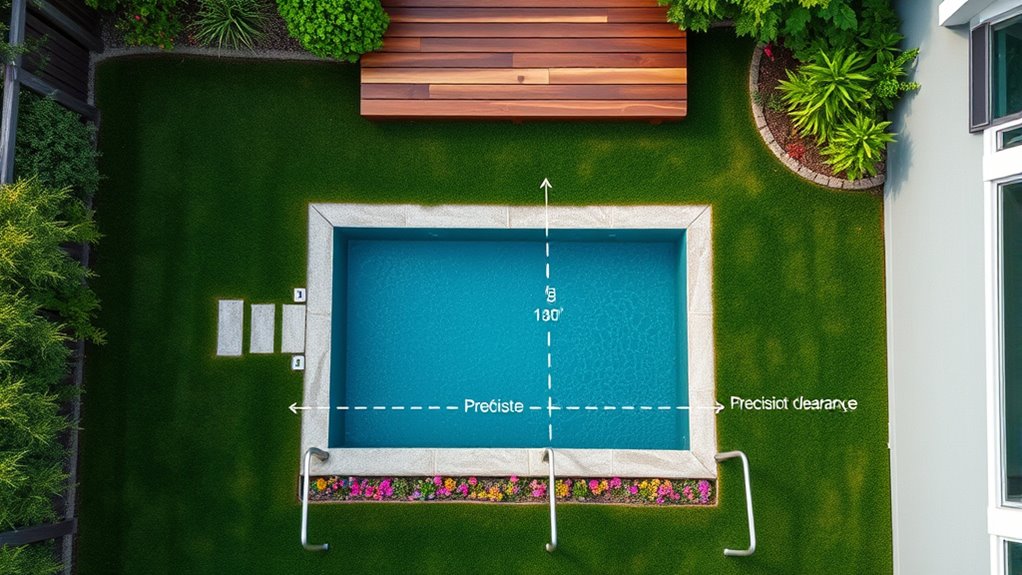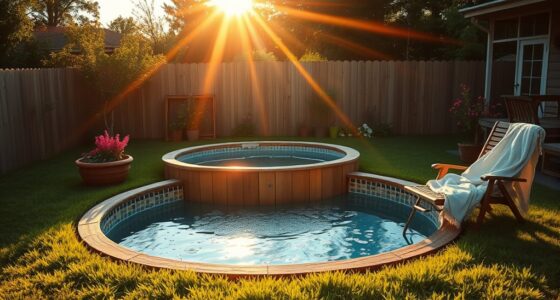When planning a small pool, you need to carefully consider setbacks and clearances to maximize safety and space. Make sure to follow local regulations, which specify minimum distances from property lines and structures, and leave enough room around the pool’s edge for safe entry, exit, and maintenance. Properly planning these clearances helps prevent accidents and legal issues. Keep exploring to discover effective design tips for making your small pool both safe and stylish.
Key Takeaways
- Ensure compliance with local setback regulations to maximize usable space and maintain safety standards.
- Maintain adequate clearance around the pool edge for safe movement and easy maintenance access.
- Incorporate safety features like fencing and non-slip surfaces within setback areas to prevent accidents.
- Use vertical landscaping and compact design elements to optimize space within setback constraints.
- Plan lighting and pathways to improve safety and usability while respecting setback and clearance requirements.

When working with limited space, careful planning becomes essential to create a functional and attractive small pool area. One of the first considerations is understanding the required clearances and setbacks around your pool. These are fundamental for ensuring pool safety, preventing accidents, and complying with local regulations. Setbacks typically specify the minimum distance your pool must be from property lines, buildings, and other structures. Ignoring these rules can lead to costly modifications later or even legal issues. By paying close attention to setback requirements, you can maximize your available space while still maintaining safety standards. Properly understanding pool setbacks helps you plan effectively and avoid potential violations. Creating a safe environment involves more than just following setback rules. You should also think about pool safety features like fencing, non-slip surfaces, and safety covers. Proper clearances around the pool edge give you enough room to move safely and prevent accidental falls. When planning your layout, leave enough space for safe entry and exit points, such as steps or ladders. This not only promotes safety but also makes maintenance easier. Small pools benefit from compact, well-thought-out designs that don’t sacrifice safety or usability. Landscaping ideas play an integral role in optimizing a small pool area. Thoughtful landscaping can help create a sense of privacy, shade, and visual appeal. Consider tall, narrow plants or vertical gardens to save space while adding greenery. Installing planters or built-in plant beds along the perimeter can also enhance aesthetics without cluttering the area. Additionally, strategic placement of trees or shrubs can provide natural shade, which is especially important in small spaces where sun exposure can be intense. Be mindful to select drought-tolerant or low-maintenance plants that won’t interfere with your pool’s operation or safety. Designing around your pool with landscaping ideas in mind can also help define different zones within the limited space. For example, a small seating area or a compact deck can be tucked into a corner, leaving more room for the pool itself. Using pavers or textured concrete can create clear pathways, reducing tripping hazards and making the area more inviting. Incorporate lighting into your landscaping plan to improve visibility at night, increasing safety and extending the usability of your pool area. These thoughtful touches make your small pool feel more spacious and cohesive. Ultimately, effective space planning for small pools involves balancing pool safety, setback compliance, and creative landscaping. With careful attention to these aspects, you’ll develop a pool area that’s not only safe but also inviting and visually appealing. This approach ensures your small pool becomes a relaxing retreat without feeling cramped or unsafe. Proper planning allows you to enjoy your backyard oasis to the fullest, making every inch work for you.
Frequently Asked Questions
What Are the Local Building Codes for Small Pool Setbacks?
You should check your local building codes for small pool setbacks, as regulations vary by area. Typically, you’ll need to maintain a certain distance from property lines, often 5 to 10 feet. Additionally, pool fencing and pool cover regulations are important for safety and compliance. Make sure your fencing is at least 4 feet high and meets safety standards, and follow cover rules to prevent accidents, especially with small pools.
How Do I Calculate Minimum Clearance Distances Around My Pool?
To calculate your minimum clearance distances, think of it as setting up a safety perimeter around your pool. Measure the distance from the pool edge to any obstacle, like pool fencing, ensuring it meets local codes and drainage requirements. Usually, you’ll need at least 4 feet of clearance on all sides for safety and maintenance. Always double-check your local regulations to confirm these distances, keeping your pool safe and compliant.
Are There Specific Safety Regulations for Small Pool Placements?
Yes, there are safety regulations for small pool placements. You should install pool fencing to prevent accidental access, especially for children. Make certain there’s enough space for utility access and maintenance without compromising safety. Local codes often specify minimum distances from property lines, obstacles, and structures. Check with your local authorities to confirm these regulations, and always follow them to keep your pool safe and compliant.
Can Existing Structures Affect Pool Setback Requirements?
Yes, existing structures can influence your pool setback requirements, especially when planning pool landscaping or water feature placement. You might need to adjust your pool’s location to comply with local regulations, ensuring safety and proper clearance. Consider how nearby buildings, fences, or trees impact your space. Consulting local codes and planning carefully helps you avoid violations and creates a safe, attractive environment for your small pool.
What Zoning Restrictions Apply to Small Pool Installations?
You need to check local zoning restrictions for small pool installations, as they often include landscaping requirements and permit application procedures. Zoning laws can differ, so you might need to submit plans showing your pool’s location and how it complies with setback rules. Contact your city or county planning department early to ensure your project meets all regulations, avoiding delays or fines.
Conclusion
So, next time you’re dreaming of a tiny pool, remember: space isn’t just about fitting it in—it’s about fitting your entire backyard’s personality. Ignore setbacks and clearances, and you might find your “mini paradise” turning into a mini disaster. But hey, who needs safety or privacy when you’ve got a pool that’s almost too small to swim in? Prioritize the details, or you might just end up with a “pool” that’s more trouble than it’s worth.








